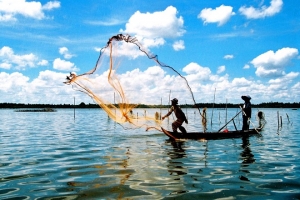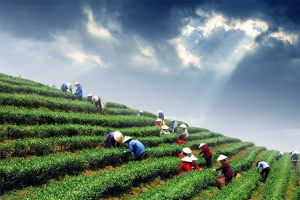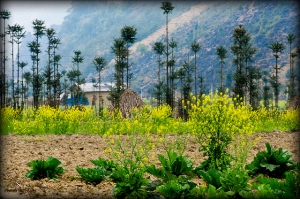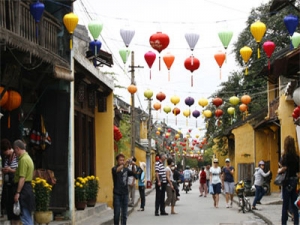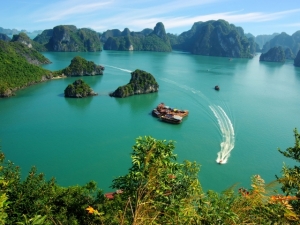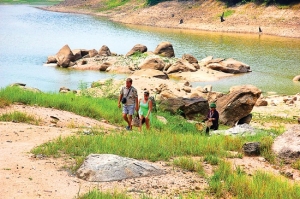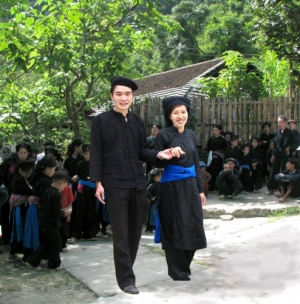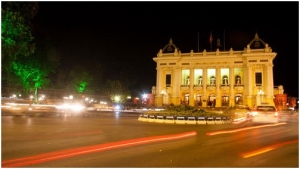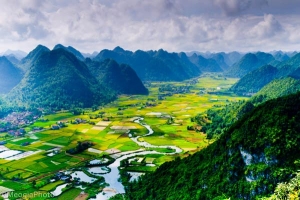
Asia Pacific Travel Team
Viet Nam enters Fodor's go list 2015
The list is based on a number of criteria, including emerging hot spots, value destinations, locations that are hosting special events in 2015, and suitable for every type of traveller-no matter what their budget or how much time they want to take off.
Fodor’s described Viet Nam as a historic but fast-changing country, stunning landscapes, and fabulous food.
According to the travel guide, Viet Nam has developed rapidly, and the 40th anniversary of the liberation of southern Viet Nam in 2015 is the perfect time to explore the iconic urban and rural scenes that have made it increasingly popular.
“Energetic cities from Ha Noi to Hoi An and to Ho Chi Minh City buzz with enticing restaurants and hotels like Hanoi's spectacular Sofitel Legend Metropole, while temples, colonial buildings, and markets retain their classic charm”, says Fodor’s.
“New options help you explore beyond Viet Nam's cities, whether you overnight on a boat in Ha Long Bay or see the towns and rice paddies of the Mekong Delta on a river cruise or by bicycle. Wherever you travel, the true friendliness of the people and reasonable costs are added benefits.”
The travel guide also advised visitors shouldn't miss Vietnamese markets, including floating ones which provide windows onto daily life. The best times to mingle with locals as they shop are earlier in the morning and in late afternoon and at night.
Rounding out of the top 25 can't-miss spots include the Arctic, the Hudson valley and the Catskills, Namibia, Guatemala, the Florida Panhandle of the US, Newfoundland of Canada, Norway, Piedmont of Italy, Patagonia of Chile, Romania, Oman, Pilsen of the Czech Republic, Barbados, Iceland, Melbourne of Australia, Singapore, Paris, Sri Lanka, Cleveland, Punta Del Este of Uruguay, Jackson Hole of Wyoming, Guadalupe Valley of Mexico, Bourbon Country and Louisville of Kentucky, and the Silk Road of China.
Lam Dong Tea Culture Week kicks off
The event, part of the Central Highlands- Da Lat National Tourism Year 2014, includes a festival honouring B’lao tea, a contest of picking tea, a tea trade fair, and an exhibition on tea products.
Besides, on December 22-23, workshops on solutions to sustainable development of Lam Dong’s tea industry will also be held.
The Lam Dong Tea Culture Week is one of the province’s key cultural events aiming to honour tea growers and processors.
It also looks to popularise the B’lao tea brands as well as boosting promotion activities of the tea production in Lam Dong province
The culture week runs through to December 25 in cities and districts of Bao Loc, Di Linh, Bao Lam and Da Lat.
The Vietnam Tea Association (Vitas) expects the country will earn 245 million USD from tea exports by the end of the year thanks to efforts to promote trade activities, reorganise production, diversify the product range, and improve the quality of tea.
Vietnam's landscapes through TV, film's lens
Chuyen Cua Pao, which won a Golden Kite award in 2005 and was presented at the Cannes Film Festival in France in 2007, depicts the life of a Mong girl named Pao. Viewers found the scenery as powerful as the narrative.
"When I came to the village, I found it even more beautiful than in the film. I remembered seeing Pao walking around cabbage flowers or weaving beside the loom," said tourist Le Viet Ha. "I was glad to visit Pao's house, a typical house of Mong people which is really alluring. I was impressed by the scenes of her brother taking the goat flock home through the wooden gate and the ancient stone ledge."
Sung La is on national road 4C, which leads to the northernmost point of Viet Nam on the Chinese border. The road connects two of the most famous tourist spots in Ha Giang province: Dong Van town and the house of Vuong Chinh Duc, a king of the ethnic minority people in Ha Giang. The beautiful village is home to the Mong people, one of the most populous minority groups in the country.
Here, tourists can see endless fields of corn like in other ethnic minority villages. However, the huge rose fields make it different from other regions. When harvested, those roses are taken to big cities like Ha Noi. Visitors often call the village the "rose of the plateau".
The black and stone houses of local inhabitants in the valley perch on mountain slopes that are covered by fog all year. The sun struggles to shine through the whole valley, creating a dreamlike scene.
The colourful costumes of Mong women going to market with horses and melodious sounds of the pan-pipe also seduce tourists.
Since the success of the film, Sung La began to develop community-based tourism, with some families offering homestay services to tourists.
"We will try not to let tourism change the lifestyle of local inhabitants," said Nguyen Cong Van, the village's chairman.
Sand dune

Another paradise recently revealed to movie lovers is Nam Cuong sand dune in southern Ninh Thuan province, which was featured in the TV series Dau Chan Du Muc (Nomadic People Footprints).
Directed by Dinh Thai Thuy and recently broadcast on Viet Nam Television, the 40-episode series was the first to feature the beauty of this region, exploring the daily life of those hired to tend cows, sheep and goats.
The 700-ha sand dune is often compared to a gold silk carpet under the glistening sun. It is surrounded by mountains, sea, rice fields, villages and pastures where cows graze tranquilly.
On the way to the sand dunes, travellers can see cacti with red and yellow flowers that are tough enough to survive the sterile land.
A shrimp farming village nearby helps tourists learn about the daily life of the local villagers. Sometimes travellers can meet Cham girls in traditional costumes with water jars on their heads and herdsmen walking with their animals. One can also see the colours of the sand change as the sun sets.
"Ninh Thuan is the driest region of Viet Nam so we faced several difficulties filming in this region. We are very happy about the beautiful images that the film offers viewers," said producer Nguyen Quang Tuyen.
Quang Nam takes measures for heritage value preservation
The province continues to collaborate with relevant agencies, international organisations and scientists to study the Cham architecture in different aspects with a view to restoring the My Son Sanctuary in a scientific and concerted manner, Nguyen Chin, Vice Chairman of the Quang Nam People’s Committee said.
Meanwhile in Hoi An ancient town, the province will take appropriate policies for collective and individual owned relics, including the provision of timber for the restoration, Chin told the December 16 conference on preserving and promoting the two UNESCO cultural heritage sites after 15 years getting the world status.
Apart from building special policies on investment and procedures for its preservation works, the province will continue carrying out its international programmes to take advantage of investment and technologies in the effort, he added
Over the past 15 years, the two heritage sites have been invested 502 billion VND (24 million USD) for preservation works from different sources.
Earlier, the Prime Minister approved plans on preserving and promoting values of the My Son Sanctuary and Hoi An ancient town for the 2008-2020 and 2012-2025 periods, respectively.-VNA
5 attractive floating markets in Vietnam
Phung Hiep floating market (Hau Giang province)

Phung Hiep floating market, also called Nga Bay, is the most unique market of this type in the Mekong Delta.
In the market, buyers and sellers bargain noisily on boats which are filled with seafood, agricultural products, housewares, and even snakes, turtles, squirrels, and lizards.
There are foods and drinks on small boats twist and turn to serve hungry sellers and buyers.
Cai Rang floating market (Can Tho province)

Cai Rang floating market, about 6km from Can Tho City, is the most famous and biggest floating market in the Mekong Delta, which starts around 05:00 and runs until mid-day.
From early morning, the waterway becomes a maze of hundreds of boats packed with fruits, vegetables, plants, and foods. Sellers hang a sample of the goods on sale on top of a long pole so that buyers can see from a distance.
The main items are farm products and specialties of Cai Rang Town, ChauThanh District and neighbouring areas.
Cai Be Floating Market (TienGiang province)

Cai Be is a biggest wholesale market in the region, which was formed in the Nguyen Dynasty in the 19th century.
The Cai Be Floating Market is always busy, bearing all the characteristics of the locals’ life in the western region. All the goods are transported to the market by boats.
The floating market lies on the Tien River, adjacent to three provinces of TienGiang, Vinh Long and Ben Tre.
Approximately 400 to 500 boats filled with fruits, vegetables, and other products are anchored along the rive banks. Boats also operate like “taxis,” very convenient for tourists.
Miet Thu floating market (KienGiang province)

The floating market in Miet Thu, with its system of entangled rivers and canals is a sight to see.
The locals in Miet Thu mainly use canoe and wooden boat as transportation means which are also their shelter.
A floating market meets on the river’s intersections where larger boats become houses to sell goods, mainly farm produce and food. Meanwhile, smaller boats drift along the canal to supply necessities to households living far from the market.
Long Xuyen floating market (An Giang province)

Although Long Xuyen floating market is not as famous as others in the southern region, tourists will still feel the generosity of southerners.
Along the banks are different landscapes. Beautiful houses are situated on one side while paddy fields and houses on stilts are on the other. The river becomes more and more bustling, especially at the river mouth.
Boats selling the same agro-product items are tied together in groups. Some boats sell fuel and offer mechanical repair services.
Ha Long Bay, Son Doong Cave named as the most breathtakingly beautiful places
In the list for 2015, Ha Long Bay in northern Quang Ninh province ranked third while the Son Doong cave in central Quang Binh province, in the seventh place.
Located 165 km from Hanoi, the capital of Vietnam, Ha Long Bay is an area comprising 1,600 islands and islets.
The majority of these land masses have not been touched by humans and have managed to retain their beauty since their creation. It is this that enabled it to be listed by UNESCO as a World Heritage Site, GlobalGrasshpper said.
Meanwhile, located approximately 500km south of Hanoi, the Son Doong cave, the largest in the world, is more than 200m wide, 150m high, and about 9km long. It houses a jungle and a river, and could fit a 40-storey skyscraper within its walls.

For centuries, men have mulled upon the existence of hollow Earth – a theory that states that the Earth is hollow. If hollow Earth did exist, than the Son Doong cave would be a testament to its existence. The cave is so large that humans exploring them would look like ants. The Son Doong cave is evidence of the world’s beauty, inside and out, the website said.
Kenh Ha Lake - Nha Trang
Kenh Ha Lake, which is also called Dong Bo Lake, covers an area of nearly 30 hectares. The lake is surrounded by high mountains and deep jungles. Even though it is actually a man-made lake, Kenh Ha has scenic views to offer, appealing to many visitors.
On the lake is a big immovable raft with buoys and composite barrels lying underneath to underpin the construction. Some simple huts are set up on the raft so that tourists can relax and go fishing. After one day, a lucky tourist can even catch dozens of big fish.
Besides, visitors can take a sightseeing tour around the lake by boat to admire the surrounding wild landscape and take photos. They can also choose to follow the trail through the deep forest leading to the high mountains to discover many spectacular natural caves formed in various shapes and sizes.
“I am really surprised on arriving at Kenh Ha Lake via instructions of the tour guide” said Dima Vilasov, 42, from Russia while he was going fishing by the lake. “It is very comfortable to relax here.”
Nearby, a dozen of other Russians also enjoyed going fishing like Vilasov to make preparations for lunch.
MODERN MEETS TRADITION
THE BLANCE BETWEEN THE OLD AND THE NEW ISS ESCPECIALLY EVIDENT AMONG VIETNAM’S ETHNIC MINORITIES IN THE COUNTRY’S REMOSTEST REGIONS
This was my second trip up to the mountains of Ha Giang province. Something about the place struck me the first time I was there and I just had to go back. This time I invited my French friend Atonio Blachez to take a motorbike trip with me.
At the end of wet season the rice terraces of Hoang Su Phi wear green coats as far as the eye can see. This part of the trip, in the southwest of Ha Giang at an elevation of several hundred metres, brought us to somewhere akin to Eden, with singing waterfalls and lush jungle invaded by gaint ferns that took us back to prehistoric times !

Dong Van Karst Park Plateau
The firtile countryside was in contrast to the second part of the trip, which took us over two mountain passes almost 2,000 metres above sea levelto the lunar landscape of the Dong Van National Park. Protected by UNESCO, the Dong Van Karst Park Plateau is well known for erosion giving the rocks in the landspace their characteristic dome-shaped form. We felt the harsh conditions of life at such a high altitude, riding through mist and rain that soaked us to the bone.
Antonie was impressed by he majesty of landscape as well as by various ethnic groups, which include Tay, H’Mong, Lolos, and Nung.
The multi-ethnic character of Vietnam is the most fascinating aspects of the country. Recognised in the Constitution, about 54 ethnic groups live on Vietnamese soil and all benefit from its development.

The Tay people in Ha Giang
“What strikes me most is the adoption of modernity in an ancient life that seems immutable” Antonie said. Each house has a satellite dish. Famers walking to the market in traditional outfits have a mobile phone glued to their ear. Paths and roads are well maintained, most of them paved.
In her book “Globalization and the Integration of Ethnic Minorities in Vietnam” anthropologist Sandrine Basilico use the word “ Viêtcommunication” to describe the process of integration if minorities into the Vietnamese nation “With this concept we mean changes […] inside ethnic minorities, but also within the ethnic majority who gets enriched [..]”
In addition to economic, cultural, educational and health policies of the State, she also emphasises the aspect of trade in goods in a market economy that effects “the culture, the way of life of the minorities with the appearance in the home of modern and westernized objects”
A distinct feature of Vietnam is the respect for traditions, which remain strong despite modernisation that is often desired by minorities themselves.
By chance, we stopped at a village of Tay people where a funeral was taking place. The abundance of offerings, of the paper votive objects, the presence of Taoist shaman, and the solidarity of the villagers to the family of the deceased testify to the permanence of traditional beliefs “The failure comply with them could incur the wrath of the spirits, spirits and ancestors on whole family or village or ethnicity” whote Ms. Balisico.
As sociologist J.Baudrillard demonstrated in his book “The system of Objects”, the possession of new objects are also symbols of a way of life and generate signs of a new culture.
Hence, material transformations induce a cultural change that can be catastrophic for traditional communities under pressure from both economic and media constraints. The concepts of “intangible cultural heritage” is recent and only in 2006 did UNESCO adopt the Convention for the Safeguarding of Intangible Cultural Heritage.
This heritage “include tradition and expressions inherited from our ancestor and passed on to our descendants, such as orals traditions, performing arts, social practices concerning nature and the universe or the knowledge and skills to produce traditional crafts”

Villagers come to help family’s deceased preparation for the funeral
The funeral made me understand the real meaning of statement. The Tay rituals reflect their belief in the cyclical nature of life. The funeral is the largest, most complex, and most expensive. It reflects many elements related to their ancestral cult. It is also desire to free and escort the deceased’s soul to the blissful land. The funeral rite steps are: Anouncing the death, inviting a shaman, shrouding the dead person, establishing the altar, preparing votive offerings, going on a specified diet, carrying out cenemonies (by a Tao) and burial.
The deceased was a father of a family of four girls and a boy. They crafted large effigies in votive paper, like kites, which will follow their father in the afterlife. The number of offerings, such as fruit, cake, alcohol and, especially, sacrificial animals – a buffalo and three pig – express the family’s wealth and importance.

A small house made by bamboo used for covering the coffin
In a procession of ries from mourners and the sounds of haunting gongs shrill flutes, offerings were brought to the altar of the deceased in a tiny room into which all participants gather. The Taoist master then began to chant magical invocations written in Chinese ideograms.

A grave of the Tay people
Intoxicated by the incense-filled air and stunned by the hallucinogenic music, I seemed to be one with the gathered assembly in a mystical fervor. As a photographer, documenting and the authenticity of their culture at the moment reward in itself for undertaking this trip.
Despite the growing global consciousness and the need to preserve intangible heritage, some decisions on the development of Ha Giang province appear completely out of place. In the master of plan for development to 2020, the region wants to build a casino in Dong Van, in the very heart of the national park, simply to attract money and tourists from China !
Defendinh minorities’s right should also be about preserving their culture and soul in the face of globalization.
The Guide
"CHAOS"
“HANOI PROMENADE” BY MARTIN RAMA, HAS RECENTLY BEEN PUBLISHED IN VIETNAMESE AND THE ENGLISH VERSION IS ON ITS WAY. “THE GUIDE” US PLEASED TO PUBLISH AN EXCERPT : THE CHAPTER ENTITLED “CHAOS”
For most foreign visitors, the first image of Hanoi is one of chaos, absolute chaos. Rivers of motorbikes thunder through its streets (sometimes, through its sidewalk) paying little attention to traffic lights and other niceties of road safely. Those motorbikes may be modest in size and in engine power, but they look unstoppable nonetheless. Even their names (Angel, Magic…) evoke a detachment from the constraints of manmade rules, if not an imminent trip to heaven. The aspiration that goes with saying “I have a Dream” is clearly not about changing the world, but about running over it. Perhaps this is what the constructors of popular motorbike model had in mind when they aptly named it…Attila !

“The first image of Hanoi is one of chaos, absolute chaos”
The sidewalks themselves do not look more reassuring. Apart from serving as improvised parking lots for legions of motorbikes and cars, they host all sorts of activities which are typically held indoors in other latitudes. Cooking and eating above all. Amids the exhaust fumes, the dust and the dirt, it’s difficult to believe that any of the food stalls would pass a basic hygiene test. The cleaning of dishes, with the same bucket of water serving for hundreds of bowls and glasses, could make the eating experience even more intimidating, at least to foreigners. And that without mentioning the bystanders who only meters away spend hours meticulously removing lice from each other’s heads.

Stalls on sidewalk
Construction on both side of the street is usually as messy as the street itself. The city’architecture heritage, which had survived two wars and a bombing campaign without irreversible damage, is under siege from uncontrolled market forces. Poverty has resulted in myriads of small living quarters of terrible quality piling up over colonial buildings and former gardens. At times, these nondescript volume of plastic, plywood and tin look simply look like vertical garbage dumps. Prosperity did not necessarily arrange matters, as traditional markets and colonial villas are now being demolished to make room for totally insipid buildings.
Well, this is the impression when one actually managers to see the buildings. More often than not, whatever there is on both sides of street id hidden behind layers of strident nylon billboards and an impossible cobweb of electricity and telephone wires. It even takes some time for the eye to distinguish, among the maze, the rusty loudspeakers from which a seemingly endless stream of squeaks and screeches pours on mornings and evenings. An inheritance from the war period, this rudimentary communication system hammers Hanoians twice a day with propaganda and public announcements that become totally unintelligible when mixed with the cacophony of rush hours.

Hanoi Opera House – A Friend colonial construction
However, most foreign visitors soon realize that this chaos is actually governed by subtle, not explicit but widely shared rules. And once those rules are understood, making sense of it all becomes easy.
Yes, traffic is a mess. But it genera;ly flows like a river, smoothly going around obstacles rather than hitting them. A pedestrian who wants to cross the street only needs to enter into the stream in a slow and predictable manner. Motorbike drivers will then marginally adjust their course and pass centimeters away on either side. The effect is even more striking an intersections, where armadas of motorbikes cross through each other without an accident, their timing as perflect as in Vienna’s baroque horse ballets. Watching Hanoi’s spontaneous traffic choreography, one can only marvel at the analytical capacity of motorbike drivers, who are constantly assessing multiple trajectories and in no time identifying a collision-free path through them (while texting message with their mobile phones, mind you…)
It does not take long to realize that the food one can eat in sidewalk food stalls is as good as in the most sophisticated restaurant, if not better. Hygeine conditions may not be ideal, but the ingredients are usually so fresh that it does not really matter. And while surroundings may be messy, they are a fascinating window on the everyday life of many ordinary Hanoians who prefer sidewalks to their crowded interiors. Peddlers do their jobs, mothers feed their children, men play Chinese chess, the elderly wander in their pijamas…And where else other than in Hanoi’s sidewalks can one see an old gentleman with a traditional goatee lovingly grooming his just bathed poodle with a pink hairdryer ?

Peddler in Hanoi
As for the accumulation of crappy living quarters, it has actually save hundreds of magnificent buildings from being demolished. Some cononial villas are so well wrapped up in new dwellings and improvised shops that it is almost impossible to see them from the street. Before any investor can buy the property rights of all the families and businesses around them one can hope that Hanoi will have adopted stronger measures to protect its architectural heritage. In the meantime, it quickly becomes a stimulating exercise to mentally “peel” layer after layer of plastic, plywood and tin to reconstruct the original shapes and proportions of the villas buried underneath.
True, many sidewalks in Hanoi look as if they had been bombared. But this ia due to the ongoing effort by the local government to put all wires underground. Many cities in the industrial world still procrastinated about doing the same, on the excuse that could be unaffordable. Much poorer Hanoi has no hestitation, and the effort is bound to make the city look even more beautiful over time.

A view of Ha Noi by night
What will happen to the rusty loudspeakers as wires go under and poles are removed is still unclear. But there is one noise that is able to offset their stream of squeaks and sreeches, and that is the blaring singing of millions of cicadas in the evening. And on some peaceful dawns, when downtown roosters have not yet stopped crowing, the loudspeaker system also seems compelled to show restraint. In lieu of the endless propaganda and public announcements, on those happy mornings it just delivers a pretty song for the city to gently wake up.
The Guide
Bac Son Valley springs into life with rice harvest
Bac Son Valley in the northern province of Lang Son is entering its peak rice harvest season.
Located in Bac Son District and 160km from Ha Noi, the valley has beautiful paddy fields surrounded by high lime mountains. The paddy fields have various kinds of colours – yellow, brown and green – as some rice fields have ripened, and others are still growing or have been harvested.
Standing on the top of a mountain, a visitor can see the paddies, the river meandering among fields and houses as well as surrounding mountains.
The valley's inhabitants are mostly ethnic Tay who live in traditional houses on stilts.
VNS


